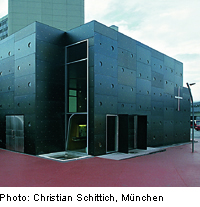Church in Vienna

Situated on a main traffic route near an underground station, the black cube of this Roman Catholic church forms a point of calm in its heterogeneous environment. The building is turned on the diagonal to the urban grid to achieve an east-facing orientation. It was also sunk to a third of its height in the ground so as not to overwhelm the housing in the neighbourhood. (Accommodated in the volume below ground are the parish rooms.) On the other hand, the outer skin of the church, consisting of black chromium-steel plates, is boldly contrasted with its surroundings, demonstrating the autonomous nature and special function of the building.
The cruciform geometry within a square block is the outcome of the glazed, indented corners. Internally, the character of the church is determined in part by the daylight entering through the grid of small openings in the facades. Incorporated in the birch lining to the eastern wall is a circle six metres in diameter with a golden cross. On the Feast of Christ the King, a beam of sunlight enters through an opening at the point of intersection of the arms and falls on the Stations of the Cross. The monolithic altar in dark-grey syenite and the ambo are raised by one step in the middle of the church, and the area is accentuated by light entering through a roof opening that symbolizes Christ’s wound. The seating is in the form of an open ring drawn about the altar and divided into three groups.
